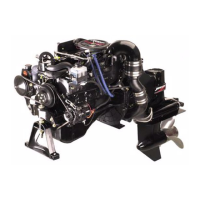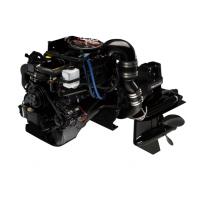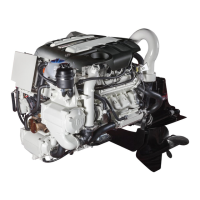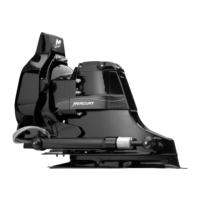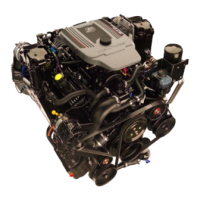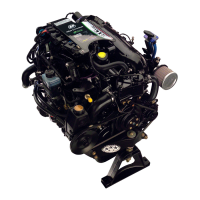Section 3 - On the Water
Page 42 90-865253073 DECEMBER 2007
Cavitation
Cavitation occurs when water flow cannot follow the contour of a fast‑moving underwater
object such as a gear housing or a propeller. Cavitation increases propeller speed while
reducing boat speed. Cavitation can seriously erode the surface of the gear housing or the
propeller. Common causes of cavitation are:
• Weeds or other debris snagged on the propeller
• Bent propeller blade
• Raised burrs or sharp edges on the propeller
Ventilation
Ventilation is caused by surface air or exhaust gases that are introduced around the
propeller resulting in propeller speed‑up and a reduction in boat speed. Air bubbles strike
the propeller blade and cause erosion of the blade surface. If allowed to continue, eventual
blade failure (breakage) will occur. Excessive ventilation is usually caused by:
• Drive unit trimmed out too far.
• A missing propeller diffuser ring.
• A damaged propeller or gear housing, which allows exhaust gases to escape between
propeller and gear housing.
• Drive unit installed too high on transom.
Elevation and Climate
Elevation and climate changes will affect the performance of your power package. Loss of
performance can be caused by:
• Higher elevations
• Higher temperatures
• Low barometric pressures
• High humidity
For you to have optimum engine performance under changing weather conditions, it is
essential that the engine be propped to allow the engine to operate at or near the top end
of the specified maximum RPM range with a normal boat load during your normal boating
weather conditions.
In most cases, recommended RPM can be achieved by changing to a lower pitch propeller.
Getting Started
20‑Hour Break‑In Period
IMPORTANT: The first 20 hours of operation is the engine break‑in period. Correct break‑in
is essential to obtain minimum oil consumption and maximum engine performance. During
this break‑in period, the following rules must be observed:
• Do not operate below 1500 RPM for extended periods of time for the first 10 hours.
Shift into gear as soon as possible after starting and advance the throttle above 1500
rpm if conditions permit safe operation.
• Do not operate at one speed consistently for extended periods.
• Do not exceed 3/4 throttle during the first 10 hours. During the next 10 hours, occasional
operation at full throttle is permissible (5 minutes at a time maximum).
• Avoid full throttle acceleration from idle speed.
• Do not operate at full throttle until the engine reaches normal operating temperature.
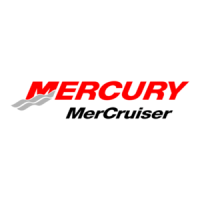
